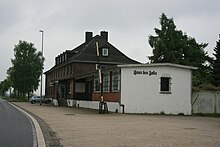Friedrichs Customs Museum
The Zollmuseum Friedrichs in Aachen - Horbach is a museum that was created in 1984 by the retired head of the main customs office in Aachen North, Christian Friedrichs, and deals with the history of customs from their development and sources of income to the protection of the local economy. In 22 rooms of offices and residential building of the former customs office Aachen-Horbach directly on the Dutch border currently has about 3000 exhibits are shown, including forbidden souvenirs and the market of illicit still .
In August 2014, the museum was included in the German Cultural Council 's Red List and placed on the pre-warning list (category 3).
building
The building complex was built in 1933 and consists of a two-story main building and an upstream, single-story terminal building. The red brick main building, which originally served as offices and apartments for the customs officers, is divided on the street side in eleven axes with rectangular windows arranged one above the other. It is covered with a hipped roof , in which there are five on the street side and four on the rear and one dormer on each of the narrow sides. The stairwell is equipped with a wooden banister. The interiors have function-related room divisions that separate the service rooms from the check-in rooms. The adjoining terminal building has a wide ramp and large windows to overlook the border traffic.
The building complex was included in the list of monuments of the city of Aachen in 1998.
Structure of the exhibition
In the former service and residential areas of the building, different topics are dealt with in seven sections, each of which builds on one another:
Historical aspects of tolls and customs
In these rooms, exhibits on tolls and customs and their development in various countries are shown. Calligraphic medieval texts and replicas of Egyptian papyri illustrate customs in the Middle Ages. The armament of a toll man , documentation on customs tariffs and customs stations explain the interplay between financial and economic policy and the state.
The literature contains works on taxation, the development of the monetary system on the subject of customs. A separate department is assigned to the Aachen area, the historical aspects of the region are examined here.
Boundaries and landmarks
In this area, the development of the boundaries and their markings as a whole as well as the specific conditions in the historical Aachen Empire and the former four-country corner as well as in today's Aachen area are shown using the example of Neustraße in Herzogenrath on over 100 panels .
Customs work
Here the administrative structures, the training and areas of activity of the customs officers and their clothing and equipment are presented, as well as the necessary technical aids and their application.
Smuggling after 1945
This section describes the special situation of Aachen as a border town on the “sinful border” both historically and with the help of smuggled items in the post-war period. In particular, the location of Aachen with its kilometer-long “green border” is discussed as well as the so-called Aachen coffee front , the notorious crow's feet and the more than 50 deaths on Aachen's smuggling trails.
The German Customs Union from 1834
In 1984 there were exhibitions in Frankfurt and Berlin on the occasion of the anniversary of the Zollverein on the subject of When the barriers fell. The German Customs Union takes place. Here the ideas of Friedrich List , Freiherr vom Stein and David Hansemann were shown . The German states wanted to endeavor to eliminate the various internal tariffs and to achieve cooperation on common tariffs. These efforts are shown in contemporary illustrations and texts.
The first session of the customs parliament in Frankfurt and also the course of the students to the Hambach Castle are shown on display boards. Differently positioned press opinions illustrate the disputes between different groups at that time. The effects are shown in examples of the development of transport, industry and trade.
The inner German border
Another focus of the exhibition is the special situation on the inner-German border until the turn of 1989/90 . In addition, the situation on the Siegfried Line with its historical development, the bunker systems and the hump line is also clearly illustrated in the form of a replica in this department .
New duties for customs
This department deals with the current tasks and structures of customs, the various areas of application, among other things, in the fight against illegal work , people and drug smuggling and the smuggling of protected recyclable materials, utensils and preparations, but also with the fight against brand piracy .
Web links
- Museum website , accessed May 1, 2014
- Brief information on the website of the City of Aachen , accessed on May 1, 2014
- Brief information on Grenzrouten.eu , accessed on May 1, 2014
- Customs Museum is fighting for its existence , report in the Aachener Zeitung from January 3, 2012, accessed on May 1, 2014
- Zollmuseum Friedrichs worries about the core of the collection , report on KingKalli , the family magazine of the Aachen city region, accessed on May 1, 2014
- Views and insights on youtube
Individual evidence
- ↑ Politics & Culture No. 5/14 | September - October 2014 Page 15 Cultural Life: The Red List ( Memento from September 3, 2014 in the Internet Archive ), accessed on August 31, 2014
- ↑ Entry in the list of monuments of the city of Aachen
Coordinates: 50 ° 50 ′ 42.5 ″ N , 6 ° 1 ′ 12.5 ″ E

